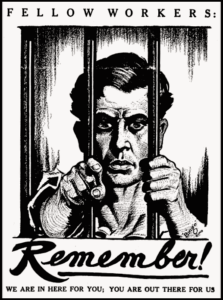You ought to be out raising hell.
This is the fighting age.
Put on your fighting clothes.
-Mother Jones
~~~~~~~~~~~~~~~~~~~~~~~~~~~~~~~~~~~~~~~~~~~~
Hellraisers Journal, Tuesday August 6, 1918
Chicago, Illinois – Francis Miller on Textile Mills and Early Death
Report on the Chicago I. W. W. Trial from Harrison George:
The first witness to take the stand on Monday, August 5, was Francis P. Miller, defendant and member of the General Executive Board. Miller was born in France in the region known as the Department of the Seine, where the great textile mills were before the war. He came to America in 1892, and has worked continuously in the textile mills of the east, and at the time of his arrest was employed by the American Woolen Company as inspector on government goods.
Testifying upon conditions in the textile mills of New England, Miller said:
The development in the textile industry has been both a development of machinery and the process of ‘speeding up.” In the cotton industry the looms and other machinery have been improved so that the worker produces 300 or 400 per cent more than he did a generation ago. In the woolen mills the machinery has not been improved to any great extent, but the workers usually have to run two machines where they ran one twenty years ago. The pay has increased a little, but not in keeping with the cost of living at all. Factory owners and trade papers say that production has increased one thousandfold, that is, over hand production. It has certainly increased 300 or 400 per cent in the last twenty-five years.
Vanderveer: Of each individual operator, you mean?
A. Yes.
Q. To what extent have wages increased?
A. Since I went to work, twenty-five years ago, perhaps 60 per cent.Upon Nebeker’s objection, Landis ruled against the introduction of the Report by New York State’s Factory Commission, headed by Samuel Gompers, so Miller proceeded to tell of the effect of wage slavery upon the textile workers:
The government reports show that the mortality rate in certain textile districts is three times as great as in other sections of the country. They show that in cities like Fall River [Massachusetts] the mortality rate of children under the age of 5 years is three times as great as in the city of San Francisco or Chicago; five times as great as in the city of Seattle. They show that female operatives die all the way from two to five times as fast from tuberculosis as women in the same cities not engaged in factory work.
Q. What is there about the industry that develops tuberculosis?
A. Dust and high speed work; dust from the fabrics and process of manufacture. I have seen charts from the Bureau of Labor where children going to work have been measured with children from the same neighborhood who have not gone into the textile mills. They show that when they leave school the average development is about the same. After a year’s work the chest development of children outside runs two to three inches higher than the chest development of children working in the mills. The thirteenth census shows wages ranging from $380 to $420 a year. That includes the wages of superintendents, managers and office help.
Q. What percentage of the fathers, the heads of families, are able to support their families on their own individual wage?
A. Practically none. It is the rule for the wife of the textile worker to work, whether they have children or not.Miller continued:
Most of the large mills in the industry have been built up out of their profits, besides the dividends declared. I recall in 1913 the Pacific Mills in Lawrence declared a stock dividend and a cash dividend of $1,800,000, and they have built up their plant from a $1,000,000 corporation to a corporation that is capitalized today at least at $15,000,000.
[Photograph added.]
~~~~~~~~~~~~~~~~~~~~~~
SOURCE
The I.W.W. Trial
Story of the Greatest Trial in Labor’s History
by One of the Defendants
-by Harrison George
—-with introduction by A. S. Embree.
IWW, Chicago, 1919
https://catalog.hathitrust.org/Record/100663067
Testimony of Francis Miller
https://babel.hathitrust.org/cgi/pt?id=umn.31951d01368761a;view=2up;seq=176
Note: First ad I can find for this book:
Butte Daily Bulletin -page 3
-Mar 5, 1919
https://www.newspapers.com/image/176048912/
IMAGE
WWIR, In Here For You, Ralph Chaplin, Sol Aug 4, Sept 1, 1917
-p323
https://libcom.org/files/rebel-voices-2_0.pdf
See also:
Tag: Francis Miller
https://weneverforget.org/tag/francis-miller/
For more on Little Falls:
Note: I highly recommend
The Red Nurse
-by Michael Cooney
https://upstateearth.blogspot.com/2011/01/iww-great-textile-strike-of-1912-in.html
~~~~~~~~~~~~~~~~~~~~~~~~~~~~~~~~~~~~~~~~~~~~

